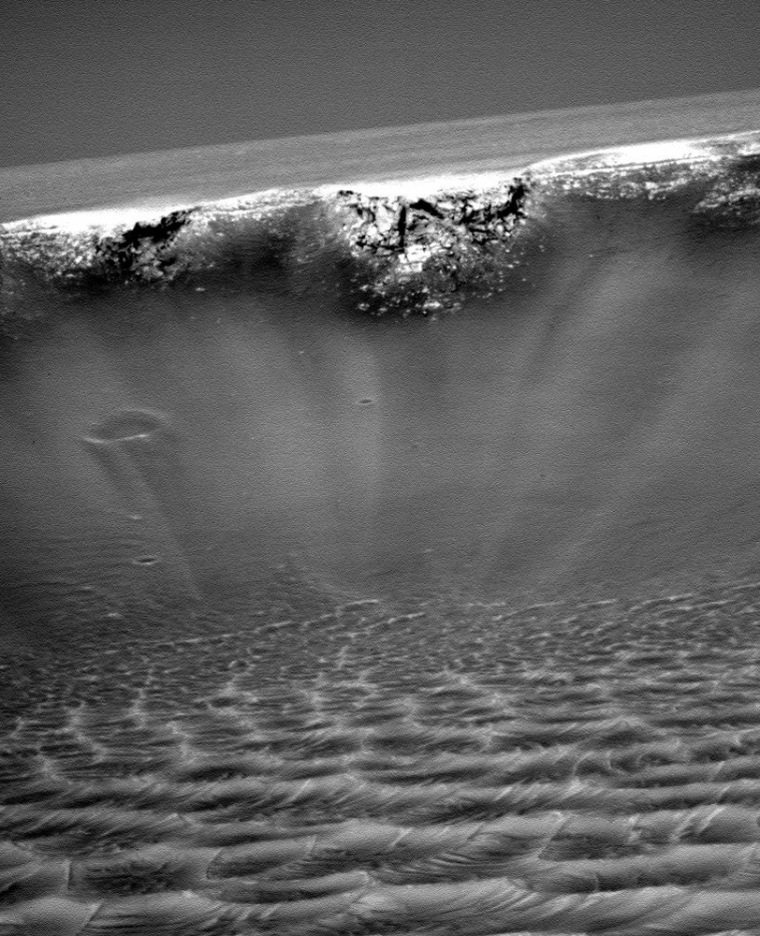NASA’s lively robotic twosome — the Spirit and Opportunity Mars rovers — are in good shape to soldier onward in their dealings with the Red Planet.
Both machines have come through superior conjunction — when the sun impedes transmissions between Mars and Earth — and are in fine shape to start new work assignments.
That solar conjunction stretched over several weeks, ending in early November. Even with the sun getting in the way of direct Earth-Mars telecommunications, the rovers didn’t get a rest.
Before the conjunction, the rovers were given science tasks to do while they stayed put — such as weather watching and self-inspecting their respective coatings of Martian dust. Stored data is now making its way from the robots to Earth via NASA’s Mars Odyssey spacecraft, which is orbiting the Red Planet.
Opportunity has reached, geologically speaking, prime real estate. The robot is surveying Victoria Crater, a huge impact crater about half a mile (800 meters) in diameter at Meridiani Planum near the equator of Mars.
On the other side of the planet, the Spirit rover is ready to take on new errands at Gusev Crater.
Approaching three years of service, the rovers have been working on Mars since landing there in January 2004.
Clockwise fashion
Cornell University's Steve Squyres, lead scientist for the Mars Exploration Rover missions, said that it was good to hear from Spirit and Opportunity again after coming through the conjunction. They are in excellent health, Squyres reported Friday on a rover Web site hosted at the university in Ithaca, N.Y.
“We’ve had to start up a little bit slowly with Opportunity because the rover’s flash memory was very full post-conjunction ... mostly with all the images we took during conjunction. It’ll take a little while to clear those out,” Squyres advised.
As for the Opportunity action plan, a decision has been made to steer the rover toward the east and north, in clockwise fashion around Victoria Crater.
“We haven’t decided how far we’ll go in that direction, but it seems clear that some of the most intriguing geology we can see from the rim is to be found that way. So that’s where we’re headed for now,” Squyres declared.
Opportunity is moving toward one of the highest spots on the crater’s rim, a tall promontory named “Cape St. Mary.”
Baby steps at first
Not to be left out in the cold, the Spirit Mars rover at Gusev Crater is being primed for more science jobs with the retreat of winter and the approach of spring.
“For the immediate future, while the [rover’s] power is still low, we’re going to focus on other targets right around us on Low Ridge,” Squyres told Space.com. “We’re talking about very small moves that will bring nearby soils and rocks within reach of the [robot’s] arm. So it’ll be baby steps at first,” he said.
Squyres added that once Spirit’s power gets high enough, rover operators will have plenty of extra energy to wheel the robot to new exploration targets. Then it’ll be time to head back to a feature called “Home Plate.”
“And unlike our last trip there, the power will be gradually increasing and we’ll be able to take our time,” Squyres added. “In fact, there are one or two tempting targets on the way to Home Plate that we think we’ll spend a little time on first.”
Once Spirit wheels back to Home Plate, Squyres said the focus will be on the western side of the plateau — a locale that has not been previously explored.
New challenge waiting
What is Home Plate in the first place? The feature conjures up a range of possibilities, including impact deposits, volcanic deposits or possibly sediment layers caused by wind or water.
“They’re all still up for grabs, but there are some hypotheses that are substantially favored over others. We’re working on a paper right now that will lay out the strengths and weaknesses of the various hypotheses,” Squyres responded.
Once the robot slides into Home Plate research mode again, just how long the Mars machinery will remain on duty there is yet to be determined.
“I don’t have any idea how long we’ll spend at Home Plate,” Squyres said. “It really depends on what we find,” he observed.
After departure from Home Plate, Spirit’s science team already has another target they’re eyeing.
“There’s a new challenge waiting,” Squyres noted. “Off toward the southwest there is some terrain that’s less than a kilometer away that has a strange ‘etched’ appearance from orbit ... completely different from anything we’ve seen before. So that’s where we’ll be headed,” he concluded.
